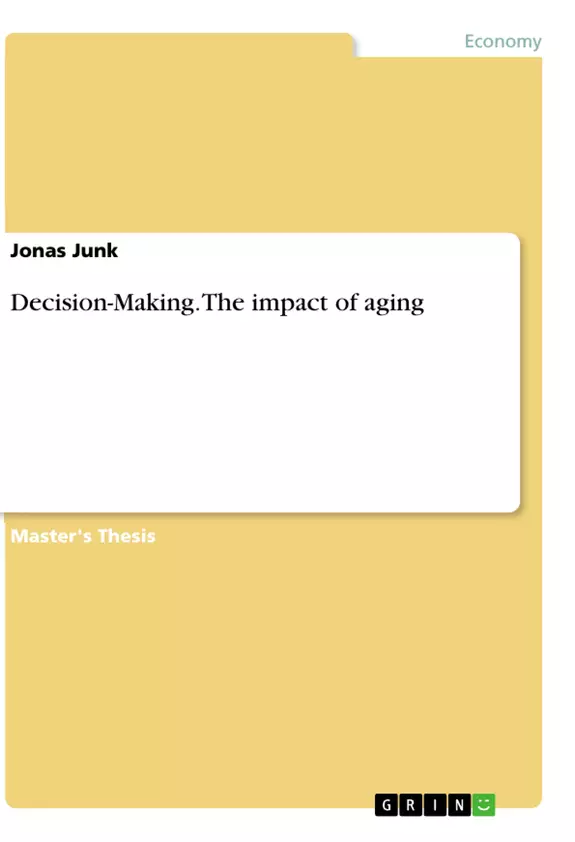The world population gets older as life expectancy increases. The popula-tion of people over the age of 60 is expected to be over two billion in 2050 (cf. United Nations, 2017, pp. 13-14). Older adults (OA) still face decisions, which might be even more significant or complex than decisions of young-er adolescents. For example, the average age of C-suite members in Ameri-can firms is 54 (cf. Korn Ferry, 2007). On a more individual level, the pop-ulation aged 55 and higher has a significantly higher mean net worth than the younger population (cf. Bricker et al., 2017, p. 13). Especially, if one accounts for the fact that research has shown that declines in cognitive functioning are seen before the age of 50 (cf. Salthouse, 2004, p. 141), re-search on aging and decision making (DM) is of high importance.
In recent years numerous papers on this topic were published. This thesis helps existing literature by creating a literature overview to summarize current findings. Because of the reasons above, this thesis concentrates on age-related differences between young and OA, but does not analyze re-search about DM in childhood. It adds to current literature by being the first work with an extensive overview of age-related changes in the respective analyzed biases with a short subsequent view on financial DM.
The thesis deals with the research question, whether biases of DM literature differ between younger and OA. To answer this question, I examine differ-ences in typical DM biases. The chosen biases are the ones being investi-gated the most thoroughly in existing literature on aging and DM and wherever possible or necessary I will focus on DM in economic contexts.
The remainder of this paper is organized as follows: section two gives a short overview about the foundations of DM. After examining age-related effects on processes, which underly DM, in chapter three, the fourth chapter deals with age-related differences in DM. Afterwards, I shine a light on potential implications resulting from respective age differences. Chapter six concludes.
Inhaltsverzeichnis (Table of Contents)
- 1 Introduction
- 2 Overview on Decision Making
- 2.1 Introduction to Decision Making
- 2.2 Common Biases in Decision Making
- 2.3 Mental Processes in Decision Making
- 3 Implications of Aging
- 3.1 Age-related Effects on Deliberative Processes
- 3.2 Age-related Effects on Experiential Processes
- 3.3 Development of Interaction between Deliberative and Experiential Processes
- 4 Age-related Differences in Decision Making
- 4.1 Negativity Bias
- 4.2 Framing Bias
- 4.3 Sunk Cost Fallacy
- 4.4 Priming Effect
- 4.5 Overconfidence Bias
- 4.6 Non-Bias Related Differences
- 5 Implications of Age Differences in Decision Making
Zielsetzung und Themenschwerpunkte (Objectives and Key Themes)
This thesis examines the impact of aging on decision-making processes, focusing on age-related differences in common decision-making biases. The research aims to explore whether these biases differ between younger individuals and older adults. The study aims to contribute to the existing literature by providing a comprehensive overview of current findings, concentrating on age-related differences, particularly in the context of economic decision-making.
- Age-related effects on deliberative and experiential processes in decision-making
- Age-related differences in common decision-making biases
- The impact of aging on financial decision-making
- The influence of biases on individual choices and outcomes
- Implications of age differences in decision-making for various contexts
Zusammenfassung der Kapitel (Chapter Summaries)
- Chapter 1: Introduction: This chapter introduces the topic of aging and its implications for decision-making, highlighting the growing population of older adults and the importance of understanding their decision-making processes. It also sets the scope and objectives of the research.
- Chapter 2: Overview on Decision Making: This chapter provides a foundational overview of decision-making, exploring traditional rational decision-making theories and their limitations. It discusses key concepts such as expected value, expected utility, and bounded rationality, and introduces the prospect theory and its explanation of risk preferences.
- Chapter 3: Implications of Aging: This chapter delves into the impact of aging on decision-making processes, examining age-related changes in deliberative and experiential processes. It explores how these changes may influence an individual's ability to weigh options, assess risks, and make informed decisions.
- Chapter 4: Age-related Differences in Decision Making: This chapter focuses on specific biases that are commonly observed in decision-making, analyzing how these biases may differ between younger and older adults. It examines biases such as negativity bias, framing bias, sunk cost fallacy, priming effect, and overconfidence bias.
- Chapter 5: Implications of Age Differences in Decision Making: This chapter discusses the potential implications of age differences in decision-making across various contexts, such as personal finance, healthcare choices, and social interactions. It explores the significance of understanding these differences for individuals and organizations.
Schlüsselwörter (Keywords)
The primary keywords and focus topics of this thesis are decision-making, aging, cognitive aging, biases, risk aversion, prospect theory, bounded rationality, financial decision-making, and the implications of age differences in decision-making.
- Quote paper
- Jonas Junk (Author), 2019, Decision-Making. The impact of aging, Munich, GRIN Verlag, https://www.grin.com/document/540413



